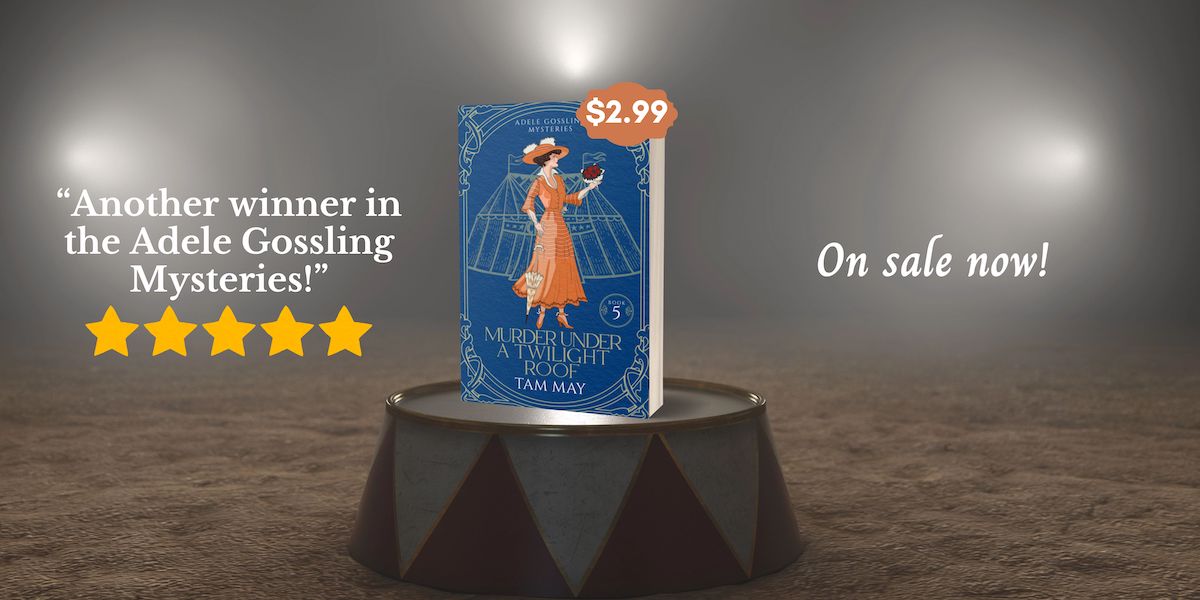
Title: The Carnation Murder
Series: Adele Gossling Mysteries (Book 1)
Author: Tam May
Genres: Historical Cozy Mystery
Release Date: April 30, 2022
California, 1903: Smart, inquisitive, and a firm believer in the new progressive reforms, Adele Gossling seeks a new life after the devastating death of her father. She flees San Francisco for the small town of Arrojo, planning a life of peace and small pleasures with nothing more exciting than selling fountain pens to the locals in her stationery shop and partaking in the town’s favorite pastime: gossip.
Peace is exactly what she doesn’t get when she discovers her neighbor’s dead body in her gazebo. The police think they have a firm suspect: the young man who was secretly engaged to the victim. But Adele and her clairvoyant new friend Nin Branch are sure he’s innocent. In spite of the raised eyebrows from Arrojo’s Victorian-minded citizens, they set out to prove the young man didn’t do it. But if he didn’t, who did?
Can Adele and Nin solve this puzzling case involving a striped carnation, a diamond ring, a note, a muddy pair of boots, and a broken promise?
You can get your copy of the book at a special promotional price from your favorite online book retailer here.
Excerpt
James showed them into the ballroom.
“I can’t imagine what you think you’ll find, Sheriff,” Adele remarked. “The servants cleared every morsel of the party ages ago.”
“One can never tell.” He examined the floor. “We already know the body was dragged from somewhere. It could have easily been from some hidden corner in this house.”
“In a house this size, it’s entirely possible,” Jackson agreed.
“I beg your pardon, sir.” James cleared his throat. “Mr. Blackstone was most particular about people straying too far from the ballroom. For young Mickey’s sake.”
“Young boys are always afraid of missing all the excitement,” Jackson said ruefully.
“He particularly asked the servants to redirect anyone who wandered past the hallway,” James continued.
“But Mr. and Miss Gossling said they saw some people going out the back door.”
“Yes, sir,” said the man. “It leads to the veranda. Mr. Blackstone had no objection to guests going out for a bit of fresh air.”
“Can you show us?”
James led them to the hall and opened the back door. The lace curtains seemed limper than they had been a few nights before. Japanese paper lanterns were still strung up, though not lit.
“It must have been quite a spectacle out here,” The sheriff remarked, eyeing them.
“We wouldn’t know,” said Jackson. “Neither Adele nor I ventured outside.”
“Quite content to watch the intrigues going on inside, eh?” Hatfield eyed him.
“Quite.” Jackson’s voice was guarded. “If Lucy was killed out here and dragged, there would be a mark somewhere.”
“I scarcely think it’s possible that she was killed here, Sheriff,” said Adele.
“And why is that?”
“The lights.” She steadied a swinging lantern with her parasol. “They would have illuminated even the slightest movement. The curtains were drawn in the ballroom and as you can see, that room overlooks this part of the veranda.”
“I see you and your brother both inherited strong powers of observation,” said Hatfield with a gleam in his eye.
About the Author

As soon as Tam May started writing when she was fourteen, writing became her voice. She writes engaging, fun-to-solve historical cozy mysteries. Her mysteries empower readers with detailed plots and a sense of “justice is done” at the end. Her fiction is set in and around the San Francisco Bay Area because she adores sourdough bread, Ghirardelli chocolate, and the area’s rich history. Tam’s current project is the Adele Gossling Mysteries. The series takes place in Northern California in the early 20th century and features amateur sleuth and epistolary expert Adele Gossling. Together with her clairvoyant friend, Nin Branch, they ensure justice is served for women, both living and dead. Tam lives in Texas but calls San Francisco and the Bay Area “home”. When she’s not writing, she’s reading classic literature, watching classic films, reading self-help books, or cooking yummy vegetarian dishes.
Social Media Links
Facebook: https://www.facebook.com/tammayauthor/
Instragram: https://www.instagram.com/tammayauthor/
Goodreads Author Page: https://www.goodreads.com/author/show/16111197.Tam_May
Amazon Author Page: https://www.amazon.com/Tam-May/e/B01N7BQZ9Y/
BookBub Author Page: https://www.bookbub.com/authors/tam-may






